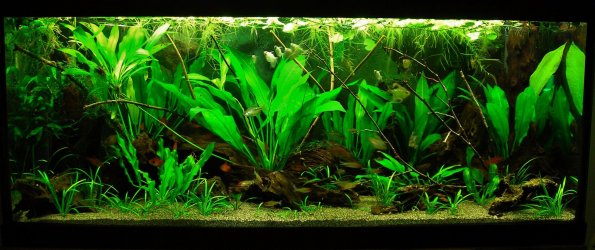Yes and no. This takes some explanation, so here comes another lengthy post but I hope it will help.
Plants like fish respire continually, taking in oxygen and giving off CO2. Some (but not all) bacteria do the same. During the daylight (which for our purposes here means the period when the tank light is on) plants continue to respire but also take in CO2 for photosynthesis, and a "waste" product of photosynthesis is oxygen. The rate of this exchange will be greater than the respiration rate, so much more CO2 is taken in than what is given off. [I should point out that the tank lighting must be of sufficient intensity to drive photosynthesis, and this level differs from plant species to species; fast growing plants need stronger light than slow growing plants because the rate of photosynthesis is proportionally faster or slower.]
At the surface of the water--and "surface" can include any point at which water and air meet--there is a gas exchange. Generally speaking, oxygen is brought in and CO2 and nitrogen gas is driven out. Creating more surface disturbance, including down below the surface by bubbling devices, will speed this up so to speak. But this can work at a disadvantage too. Too much oxygen entering and CO2 exiting the water during daylight will be detrimental to plants. During darkness, when fish and plants are taking in oxygen and giving off CO2, this may help provide more oxygen. Generally this is not necessary, but in heavily planted tanks it may become necessary (at night), depending upon the plant load and fish load and normal surface disturbance (which is primarily the job of the filter).
There is some current thought that the surface disturbance should be greater than we used to hold, and that doing this will increase the CO2 entering the tank water rather than leaving it. I dug into this concept a few years back when I first came across it but was unable to find any evidence anywhere as to the exact numbers. So to my mind, the concept is unproven, and therefore doubtful. However, I am convinced that some surface disturbance is not as "negative" for plants as perhaps we once thought. I would provide decent surface disturbance day and night, but not go to excess. This seems to work for me. In one of my tanks, which happens to be the heaviest planted and with the most fish, I was seeing evidence of an oxygen shortage (not critical, but it was evident) in the early morning; I increased the surface disturbance created by the spray bar of the canister filter, and the evidence disappeared. The "evidence" was slightly increased respiration by fish, especially the cories, including more frequent surfacing. Now that the surface disturbance is increased just a bit, this "evidence" disappeared and in the morning the fish are respirating as I would expect. So clearly there was a difference. For illustration, I'll attach a photo of this tank (it's a 4-foot 70 gallon). The light is on for 7 hours daily, on a timer, which is the max or algae begins to increase (due primarily to the reduction of natural CO2).
Byron.




 At that point I just pull bits off (the moss, that is--not my hair, I leave that for the barber to pull out). I've never bothered trimming it, primarily because I don't want it to looked trimmed like a lawn, but natural (again referring to the moss, though my hair isn't much different).
At that point I just pull bits off (the moss, that is--not my hair, I leave that for the barber to pull out). I've never bothered trimming it, primarily because I don't want it to looked trimmed like a lawn, but natural (again referring to the moss, though my hair isn't much different).